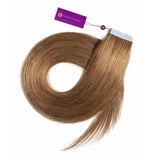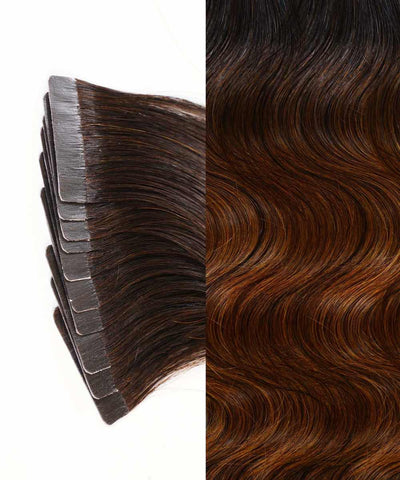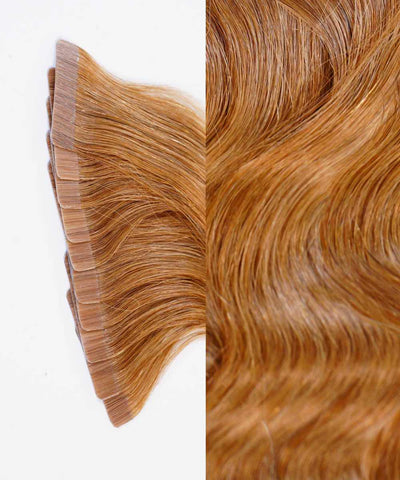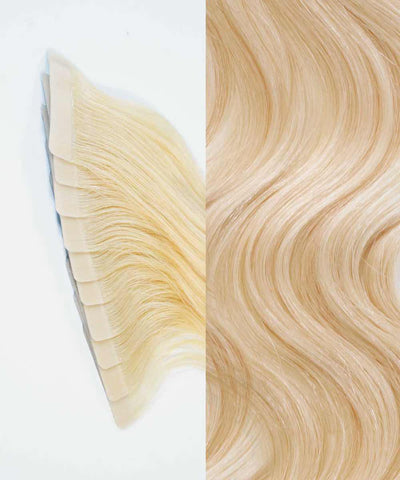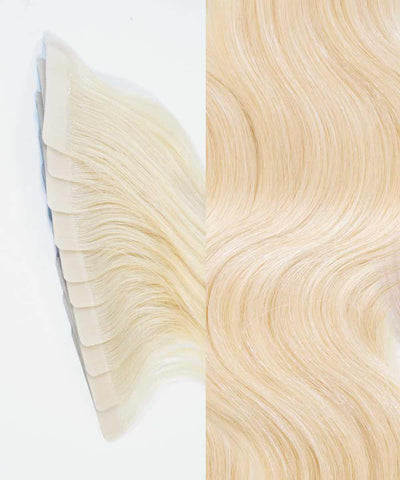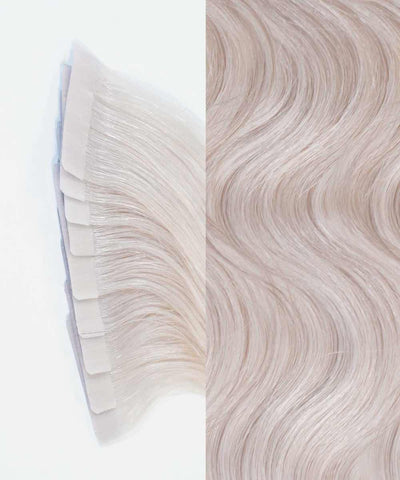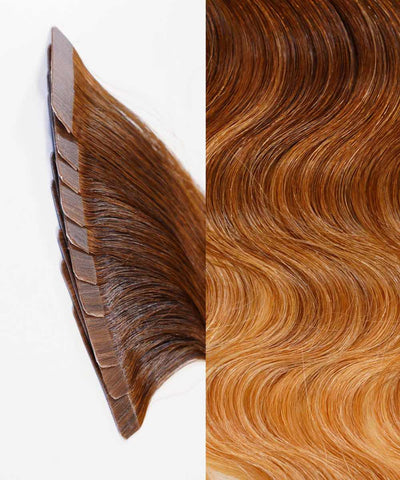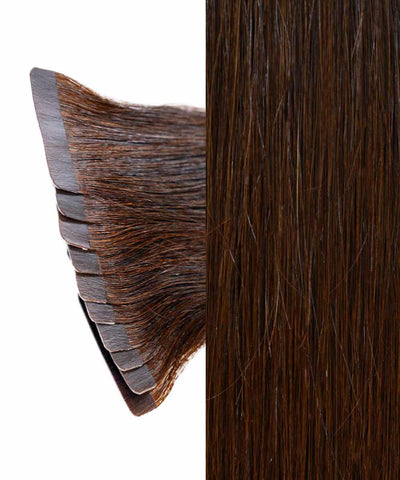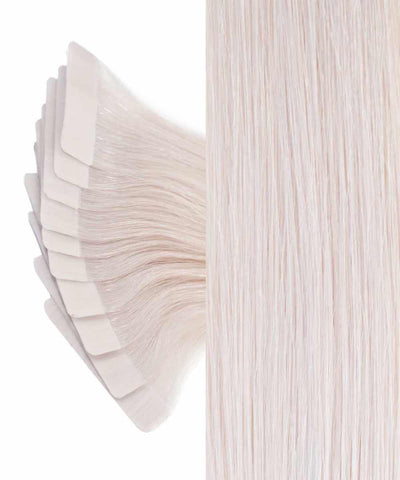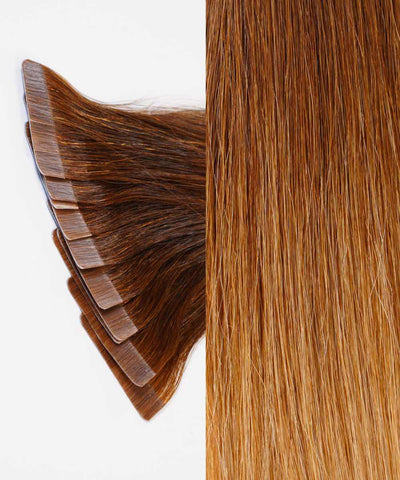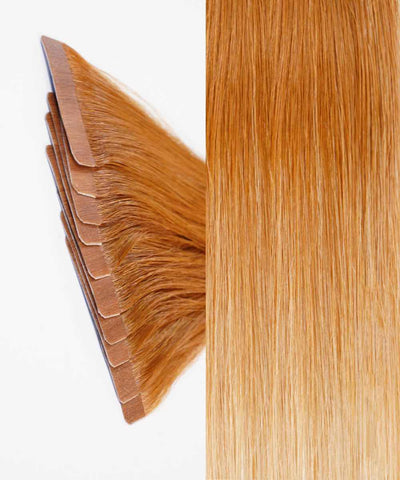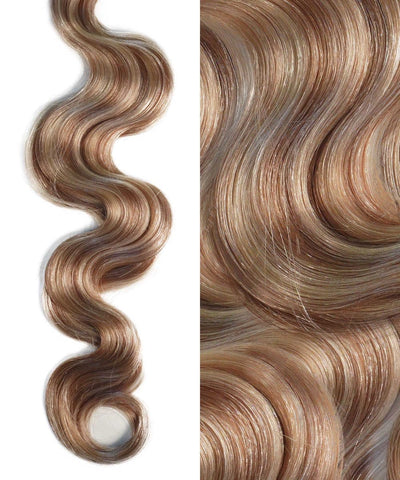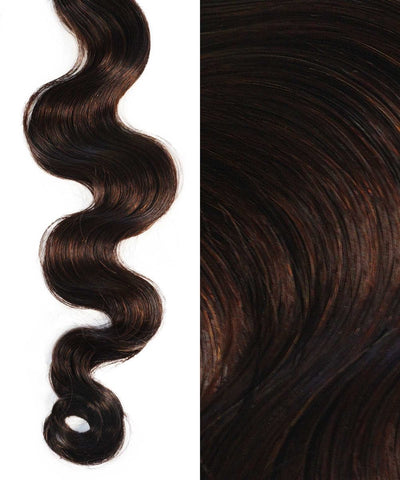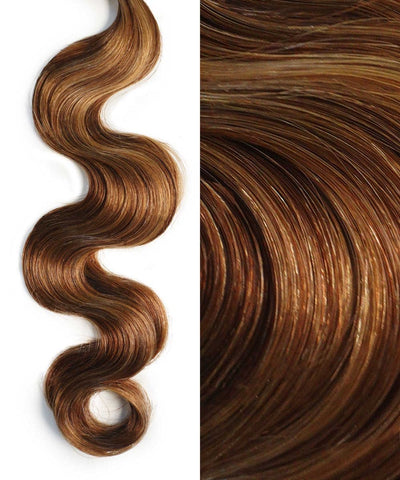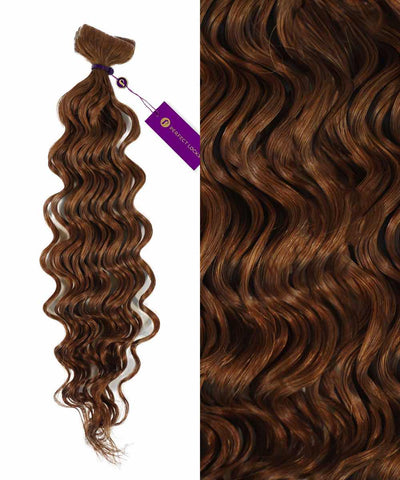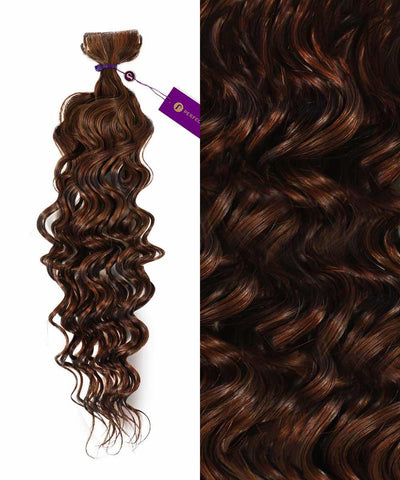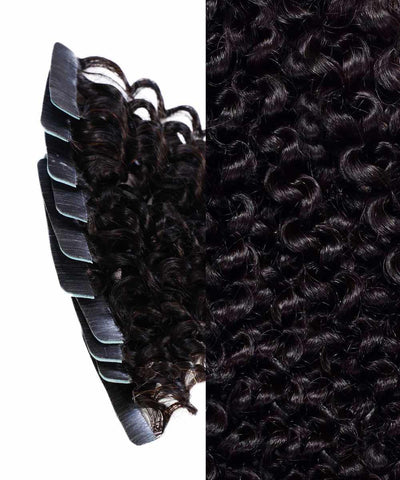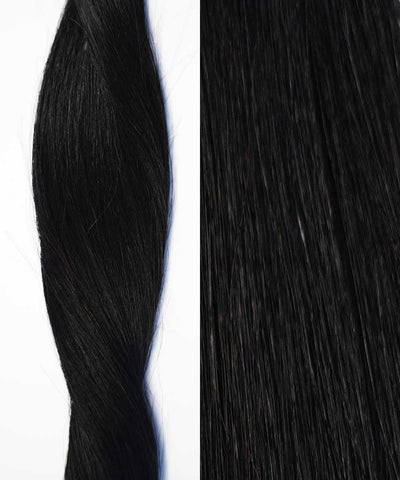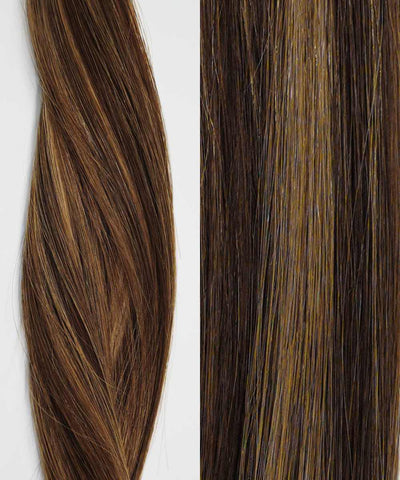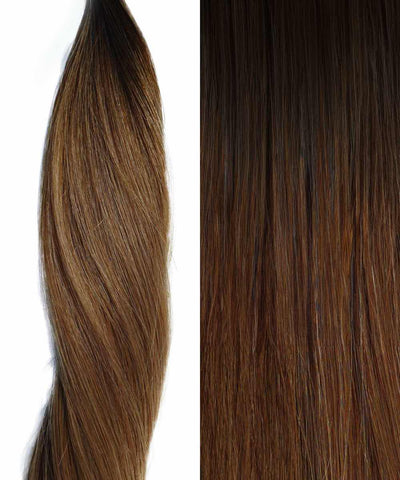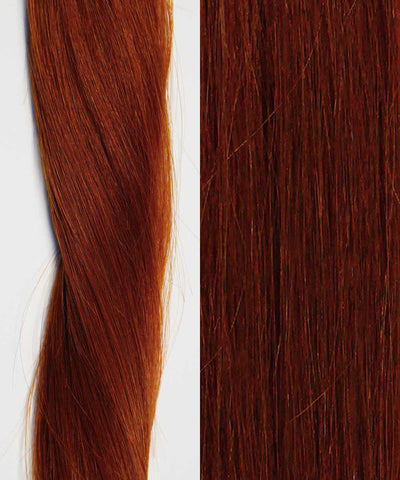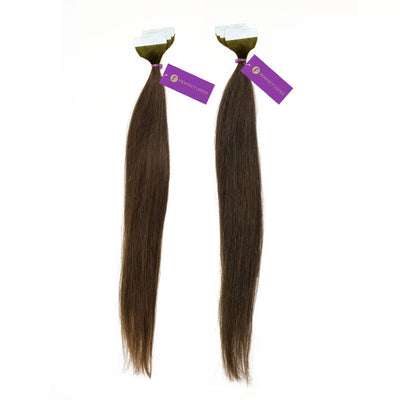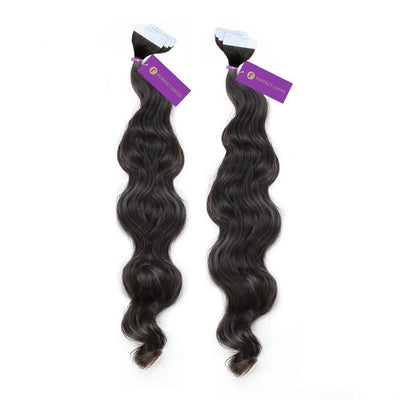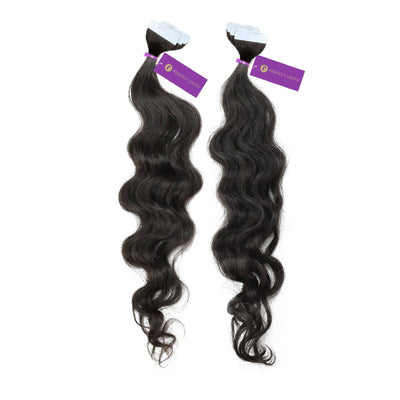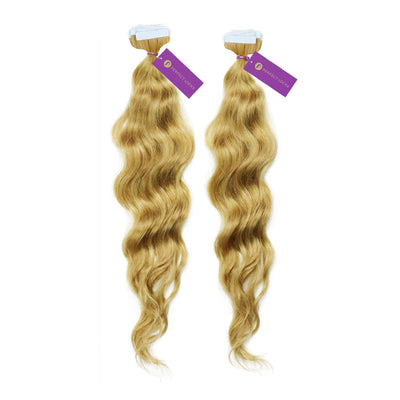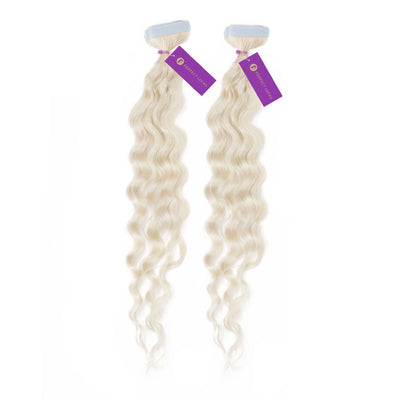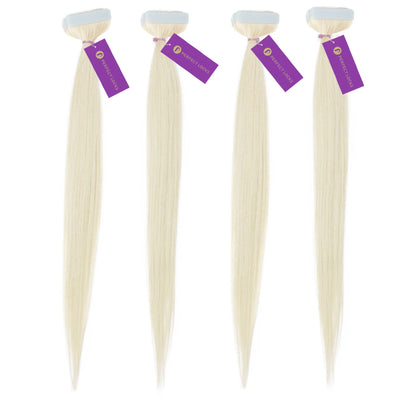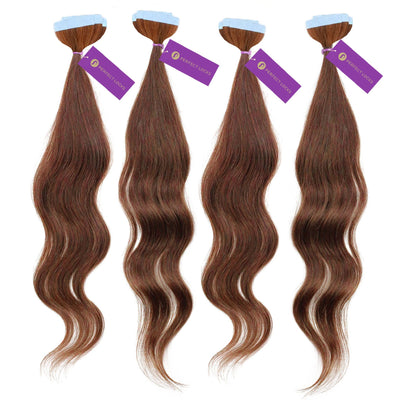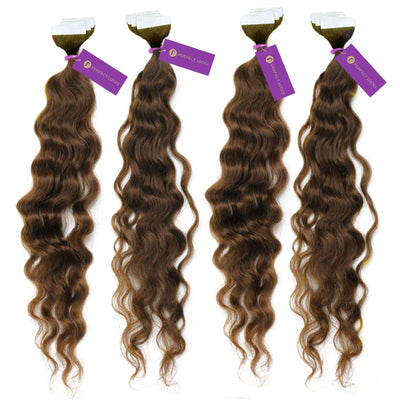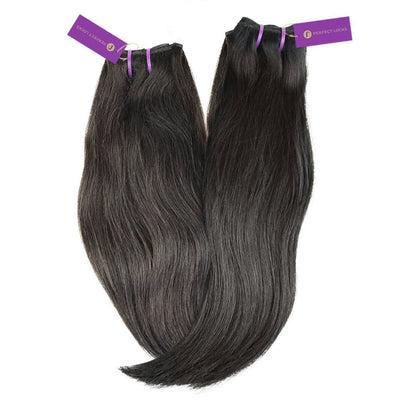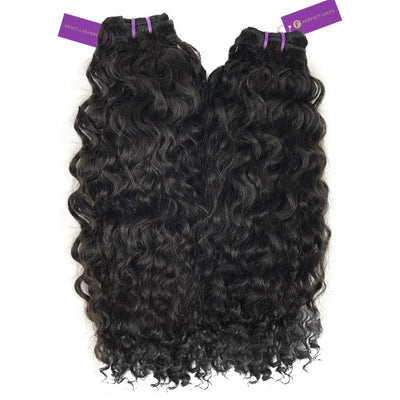Choosing the right hair extension method for you is sometimes overwhelming because of the various extension choices out there. One question that clients ask is the difference between tape-in vs sew-in hair extensions. If you are excited to get hair extensions, but can’t decide between tape-ins or sew-ins, then this blog post is for you!
You will learn about:
What are tape-in hair extensions?
- What are sew-in hair extensions?
- The differences between tape-in and sew-in hair extensions
- Frequently Asked Questions about tape-ins and sew-ins
What are tape-in hair extensions?
Tape-ins or tape hair extensions are considered semi-permanent extensions because they can last up to 6 weeks. They are designed to be small sections of wefts (about 1.5 inches in width) and they come with an adhesive tape that you can attach to your own, natural hair.
They are great for women who don’t have the time to style their hair everyday, but who want extensions that can add volume and length to their hair perfectly. Tape-ins are designed to be flat and thin so they don’t add stress to your natural hair when you’re wearing them.
You can transform your hair using Perfect Locks’ tape hair extensions that are designed to be ultra lightweight and non-damaging to your own hair.
What are sew-in hair extensions?
Sew-in hair extensions are the most permanent type of extensions. Why? Because they are extensions that need to be sewn into your natural hair. They are a good option if you have thick or more textured hair. You can choose from a variety of weaves if you’re interested in this extension method.
To install the weaves properly, a professional usually applies the extensions to your hair as the process takes time and is too hard for you to do at home. For less hassle, just bring your chosen weave to a hair extensions salon and let your stylist apply them for you. Because of this application method, this type of extensions tend to last long on your hair.
Since many weaves offer different hair textures, colors, and thickness, make sure to pick the right one that resembles your natural hair closely. Depending on your personal preference, here are some wefts you can choose from when you are planning to do the sew-in method:
Hand-Tied Wefts
Hand-tied weft extensions are made by putting together strands of hair by hand. They are one of the most popular extensions out there. Many women like them because they are thin and lightweight, so they give a natural feel and blend well with your real hair. This also makes them easier to conceal.
Machine Wefts
Machine weft extensions are usually thicker and heavier compared to hand-tied wefts because they are made using a sewing machine. They are perfect for women with thicker hair textures.
Learn more about hand-tied and machine-tied extensions in our blog here.
Beaded Wefts
Beaded wefts are strands of hair extensions where your stylist can use some beads, a needle, and a weaving thread to attach them to your real hair. These wefts are pre-styled or pre-cut and they can come with their own microbeads already, so it’s easier and faster to apply them. They are a great alternative to fusion methods. Beaded wefts also offer good security so you can enjoy them for weeks and months to come.
Choose high-grade wefts that are a great investment in the long run. Perfect Locks’ Weft Bundle Deals come with hair extensions that are made from 100% Remy human hair - the gold standard for hair extensions!
Types of Wefts

Hand-Tied Wefts

Machine Wefts

Hand-Tied Rows

Beaded Rows
The difference between tape-in extensions vs sew-in extensions
Tape-ins and sew-ins are two of the most favorite hair extension types that women go for in the market today. The two may have similarities, but they also have differences such as in the way they are applied, their price range, styling and others.
Difference #1: The installation process
When it comes to installation, the best way to apply the two extensions is through the help of professional stylists. In this way, you can ensure that your real hair will also be properly managed. However, they have very different application methods.
Tape in hair extensions are attached using adhesive that usually already comes when you buy your tape-ins. A common way stylists install them is to sandwich your own hair between two tape extensions to add more volume. The number of extensions to use will depend on how much volume or length you want to add to your hair. While tape-in extensions are easy to install, they are also easy to remove.
Machine, beaded, or hand tied extensions are typically installed by sewing them directly into your real hair using a weaving thread, needle, and/or microbeads. First, your stylist will need to prepare your hair for the installation. They may wash your hair or give you a haircut to match with the extensions. Then, the installation begins. Usually, your stylist will apply the extensions by braiding your hair into cornrows close to your scalp, then sowing the extensions to the braid. Or, they can install a row of beads to your hair where they will stitch the extensions to.
That said, it can take hours for your stylist to finish installing your sew-in extensions properly. On the other hand, it only takes about an hour or two to finish installing tape in extensions, or sometimes even less. You will have to decide how long you are willing to spend time at the salon, not just during installation, but also in maintaining your extensions.
Difference #2: Extensions aftercare and maintenance
When you have tape-in extensions, make sure not to wet your hair or exercise right away, causing you to sweat a lot. The perspiration may cause your tape-ins to slip. So, it’s best to wait at least 48 hours after installation to do any activities that can make your hair wet.
When it comes to maintaining your hair extension, you will need to visit your salon after 6 weeks for tape-ins and after about 8 weeks for sew-ins. This is important because your stylist will need to re-adjust them closer to your scalp since your hair growth can cause the weaves or the tapes to be exposed.
You will also need to wash your hair at least once a week to keep them clean. When applying any products to your hair, opt to use salon-recommended products such as those that are sulfate-free or alcohol-free.
Curious about more tips? Read our blog on How To Make Your Tape In Hair Extensions Last Longer.
Difference #3: Cost and budget
The cost can be one of the deciding factors for what extensions you will be going for. And, tape-ins and sew-in extensions vary in pricing. Many clients consider tape-ins to be more budget-friendly. Tape in extensions are typically less expensive compared to sew-in hair extensions methods because tape-ins take lesser time, tools, and effort to install them. Although sew-in hair extensions can be more expensive, this is reasonable because of the hours it takes for your stylist to complete your new look. They also last longer than tape hair extensions.
Overall, in thinking about the cost, you’ll also have to consider the education and training that your stylist underwent to make sure that your hand tied extensions or tape in hair extensions are installed properly - and to protect your natural hair in the long run.
Difference #4: Styling and versatility
Both hair extensions methods let you style your hair naturally. You can achieve many hairstyles with tape hair extensions, but doing updos can be a bit tricky since you’ll need more hair length to make sure the tapes are concealed enough.
Using machine, beaded, or hand tied extensions give you more freedom to achieve more hairstyles. You can put your hair in an updo or a high ponytail. So, if you are someone who likes to keep their hair up, using these is great for you. Hand tied wefts feel and look natural because of their thinner and lighter strands so they can give you a lot of styling options too.
Difference #5: Volume
Decide also if you want a head full of hair extensions or not. Clients who wear tape extensions can create volumized hair. But, if you want a full volume of hair for a longer time, consider using hand tied extensions since they allow for easier concealment of the hair and generally last longer than tape hair extensions. Multiple hand tied rows that are used for beaded installation or sewing methods are easy to stack together on a single row to help build more volume but still keep your hair natural-looking.
Difference #6: Color
Color plays a major role in achieving a seamless, natural look with hair extensions, and the method you choose—tape-in or sew-in—can influence your color options and final result.
Tape-in extensions are excellent for adding pops of color, highlights, or lowlights without chemically treating your natural hair. Because they are applied in smaller sections, stylists can strategically place different shades to create depth or dimension. They’re especially great for those looking to blend in subtle blonde tones or add brightness around the face. If you’re aiming for a lighter look, explore our collection of blonde tape-in hair extensions for beautifully blended options.
Sew-in extensions offer a different kind of flexibility, especially when going for bolder color transformations. Since they allow more hair to be added at once, they’re perfect for dramatic changes or all-over color. With options like hand-tied or machine wefts, stylists can layer in multiple shades to create a multidimensional look. Our blonde weaves are a popular choice for those who want full-coverage color with added volume and longevity.
No matter which method you choose, always work with a stylist to color match accurately, and maintain vibrancy with sulfate-free, color-safe products.
Frequently Asked Questions
What’s a safer hair extension method for me?
Both hair extensions methods are perfectly safe to use when installed correctly. When you go to your salon, it is likely that your professional stylist will evaluate your hair type before proceeding to install your extensions and advise you all about the method that’s perfect for you.
What extensions are better suited for thicker hair?
Tape-in hair extensions work for clients of all hair types. This is also true for hand-tied wefts, machine, or beaded wefts, but these extensions tend to work better for clients with thicker, coarser hair. This is because they need a stronger base to attach or sew the hair extensions in. Now, this doesn’t necessarily mean that you stay away from sew-ins if you have fine hair. Your hairstylist can still use hand-tied wefts and match the extension weight to your real hair’s density and texture to avoid any breakage or damage to your hair. Ultimately, your hairstylist will be able to advise you further about the best extensions method to use based on your hair type.
What extension is better suited for fine hair?
Tape-in hair extensions are great for ladies of all hair types; they are generally better for ladies with thin hair. They come in straight, curly, wavy or even kinky hair textures. However, if you want to go for the sew-in method, you can still opt to wear hand-tied wefts especially if you want to invest in longer-lasting extensions for your thin hair.
What extension is better suited for short hair?
For short-haired ladies, it is better to choose an extension that is sewn to your natural hair. It’s harder to conceal tape-in extensions when you have short hair, especially if you want to pull your hair up in a ponytail. On the other hand, going for hand-tied wefts can give you more concealment even when your hair has grown out.
How do I sleep with my extensions on?
When sleeping with semi-permanent extensions, you can preserve their quality longer by using a hair cap or keeping your hair in a loose braid to avoid them from tangling. Invest also in a good-quality satin-silk pillowcase. Silk pillowcases are known to take good care not only of your facial skin, but also of your hair. They help retain moisture and reduce friction that prevents your hair from tangling or matting throughout the night.
So, which one is right for you: sew-in or tape-in extensions?
Now that you know about these two hair extension methods, how they are applied, and how they are used, you can decide which one suits you best. If you have thin fine hair and don’t really want a long-term commitment yet, tape-in extensions can be a great match for you. If you have normal to thick hair and want to invest on high-grade weaves in the long run, you can try out sew-in extensions. It all depends on your personal preference and what you want your hair goals to be.
Now that you are ready to decide, browse our great quality Perfect Locks’ tape-in hair extensions and wefts to help you start your hair extension journey!









